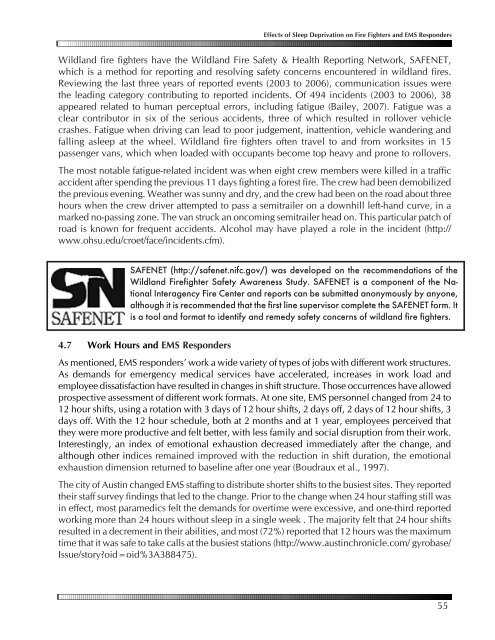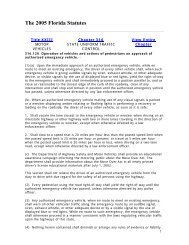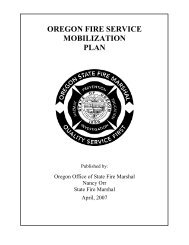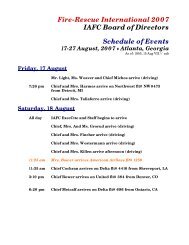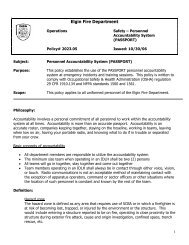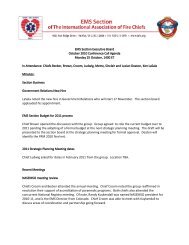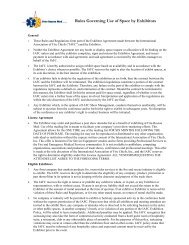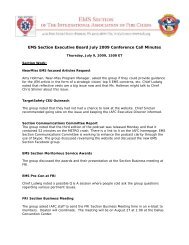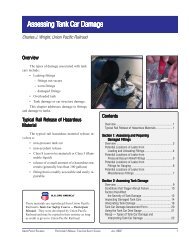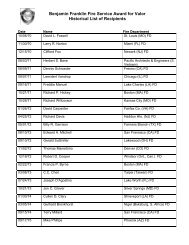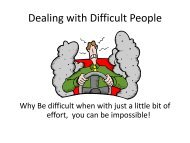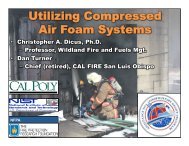Effects of Sleep Deprivation on Fire Fighters and EMS ... - NAEMT
Effects of Sleep Deprivation on Fire Fighters and EMS ... - NAEMT
Effects of Sleep Deprivation on Fire Fighters and EMS ... - NAEMT
You also want an ePaper? Increase the reach of your titles
YUMPU automatically turns print PDFs into web optimized ePapers that Google loves.
<str<strong>on</strong>g>Effects</str<strong>on</strong>g> <str<strong>on</strong>g>of</str<strong>on</strong>g> <str<strong>on</strong>g>Sleep</str<strong>on</strong>g> <str<strong>on</strong>g>Deprivati<strong>on</strong></str<strong>on</strong>g> <strong>on</strong> <strong>Fire</strong> <strong>Fighters</strong> <strong>and</strong> <strong>EMS</strong> Resp<strong>on</strong>ders<br />
Wildl<strong>and</strong> fire fighters have the Wildl<strong>and</strong> <strong>Fire</strong> Safety & Health Reporting Network, SAFENET,<br />
which is a method for reporting <strong>and</strong> resolving safety c<strong>on</strong>cerns encountered in wildl<strong>and</strong> fires.<br />
Reviewing the last three years <str<strong>on</strong>g>of</str<strong>on</strong>g> reported events (2003 to 2006), communicati<strong>on</strong> issues were<br />
the leading category c<strong>on</strong>tributing to reported incidents. Of 494 incidents (2003 to 2006), 38<br />
appeared related to human perceptual errors, including fatigue (Bailey, 2007). Fatigue was a<br />
clear c<strong>on</strong>tributor in six <str<strong>on</strong>g>of</str<strong>on</strong>g> the serious accidents, three <str<strong>on</strong>g>of</str<strong>on</strong>g> which resulted in rollover vehicle<br />
crashes. Fatigue when driving can lead to poor judgement, inattenti<strong>on</strong>, vehicle w<strong>and</strong>ering <strong>and</strong><br />
falling asleep at the wheel. Wildl<strong>and</strong> fire fighters <str<strong>on</strong>g>of</str<strong>on</strong>g>ten travel to <strong>and</strong> from worksites in 15<br />
passenger vans, which when loaded with occupants become top heavy <strong>and</strong> pr<strong>on</strong>e to rollovers.<br />
The most notable fatigue-related incident was when eight crew members were killed in a traffic<br />
accident after spending the previous 11 days fighting a forest fire. The crew had been demobilized<br />
the previous evening. Weather was sunny <strong>and</strong> dry, <strong>and</strong> the crew had been <strong>on</strong> the road about three<br />
hours when the crew driver attempted to pass a semitrailer <strong>on</strong> a downhill left-h<strong>and</strong> curve, in a<br />
marked no-passing z<strong>on</strong>e. The van struck an <strong>on</strong>coming semitrailer head <strong>on</strong>. This particular patch <str<strong>on</strong>g>of</str<strong>on</strong>g><br />
road is known for frequent accidents. Alcohol may have played a role in the incident (http://<br />
www.ohsu.edu/croet/face/incidents.cfm).<br />
SAFENET (http://safenet.nifc.gov/) was developed <strong>on</strong> the recommendati<strong>on</strong>s <str<strong>on</strong>g>of</str<strong>on</strong>g> the<br />
Wildl<strong>and</strong> <strong>Fire</strong>fighter Safety Awareness Study. SAFENET is a comp<strong>on</strong>ent <str<strong>on</strong>g>of</str<strong>on</strong>g> the Nati<strong>on</strong>al<br />
Interagency <strong>Fire</strong> Center <strong>and</strong> reports can be submitted an<strong>on</strong>ymously by any<strong>on</strong>e,<br />
although it is recommended that the first line supervisor complete the SAFENET form. It<br />
is a tool <strong>and</strong> format to identify <strong>and</strong> remedy safety c<strong>on</strong>cerns <str<strong>on</strong>g>of</str<strong>on</strong>g> wildl<strong>and</strong> fire fighters.<br />
4.7 Work Hours <strong>and</strong> <strong>EMS</strong> Resp<strong>on</strong>ders<br />
As menti<strong>on</strong>ed, <strong>EMS</strong> resp<strong>on</strong>ders’ work a wide variety <str<strong>on</strong>g>of</str<strong>on</strong>g> types <str<strong>on</strong>g>of</str<strong>on</strong>g> jobs with different work structures.<br />
As dem<strong>and</strong>s for emergency medical services have accelerated, increases in work load <strong>and</strong><br />
employee dissatisfacti<strong>on</strong> have resulted in changes in shift structure. Those occurrences have allowed<br />
prospective assessment <str<strong>on</strong>g>of</str<strong>on</strong>g> different work formats. At <strong>on</strong>e site, <strong>EMS</strong> pers<strong>on</strong>nel changed from 24 to<br />
12 hour shifts, using a rotati<strong>on</strong> with 3 days <str<strong>on</strong>g>of</str<strong>on</strong>g> 12 hour shifts, 2 days <str<strong>on</strong>g>of</str<strong>on</strong>g>f, 2 days <str<strong>on</strong>g>of</str<strong>on</strong>g> 12 hour shifts, 3<br />
days <str<strong>on</strong>g>of</str<strong>on</strong>g>f. With the 12 hour schedule, both at 2 m<strong>on</strong>ths <strong>and</strong> at 1 year, employees perceived that<br />
they were more productive <strong>and</strong> felt better, with less family <strong>and</strong> social disrupti<strong>on</strong> from their work.<br />
Interestingly, an index <str<strong>on</strong>g>of</str<strong>on</strong>g> emoti<strong>on</strong>al exhausti<strong>on</strong> decreased immediately after the change, <strong>and</strong><br />
although other indices remained improved with the reducti<strong>on</strong> in shift durati<strong>on</strong>, the emoti<strong>on</strong>al<br />
exhausti<strong>on</strong> dimensi<strong>on</strong> returned to baseline after <strong>on</strong>e year (Boudraux et al., 1997).<br />
The city <str<strong>on</strong>g>of</str<strong>on</strong>g> Austin changed <strong>EMS</strong> staffing to distribute shorter shifts to the busiest sites. They reported<br />
their staff survey findings that led to the change. Prior to the change when 24 hour staffing still was<br />
in effect, most paramedics felt the dem<strong>and</strong>s for overtime were excessive, <strong>and</strong> <strong>on</strong>e-third reported<br />
working more than 24 hours without sleep in a single week . The majority felt that 24 hour shifts<br />
resulted in a decrement in their abilities, <strong>and</strong> most (72%) reported that 12 hours was the maximum<br />
time that it was safe to take calls at the busiest stati<strong>on</strong>s (http://www.austinchr<strong>on</strong>icle.com/ gyrobase/<br />
Issue/story?oid=oid%3A388475).<br />
55


